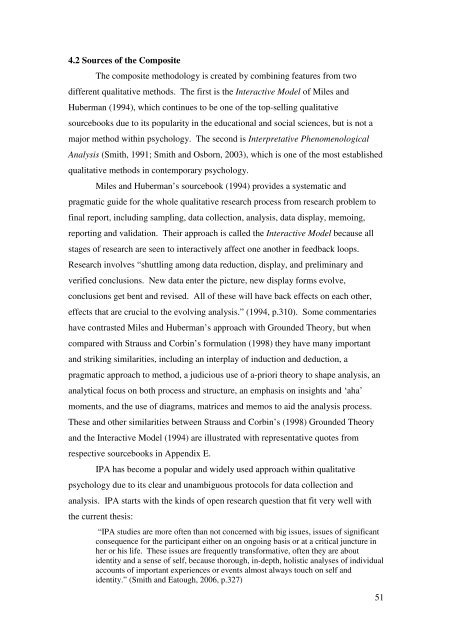DEVELOPMENTAL CRISIS IN EARLY ADULTHOOD: A ...
DEVELOPMENTAL CRISIS IN EARLY ADULTHOOD: A ...
DEVELOPMENTAL CRISIS IN EARLY ADULTHOOD: A ...
Create successful ePaper yourself
Turn your PDF publications into a flip-book with our unique Google optimized e-Paper software.
4.2 Sources of the Composite<br />
The composite methodology is created by combining features from two<br />
different qualitative methods. The first is the Interactive Model of Miles and<br />
Huberman (1994), which continues to be one of the top-selling qualitative<br />
sourcebooks due to its popularity in the educational and social sciences, but is not a<br />
major method within psychology. The second is Interpretative Phenomenological<br />
Analysis (Smith, 1991; Smith and Osborn, 2003), which is one of the most established<br />
qualitative methods in contemporary psychology.<br />
Miles and Huberman’s sourcebook (1994) provides a systematic and<br />
pragmatic guide for the whole qualitative research process from research problem to<br />
final report, including sampling, data collection, analysis, data display, memoing,<br />
reporting and validation. Their approach is called the Interactive Model because all<br />
stages of research are seen to interactively affect one another in feedback loops.<br />
Research involves “shuttling among data reduction, display, and preliminary and<br />
verified conclusions. New data enter the picture, new display forms evolve,<br />
conclusions get bent and revised. All of these will have back effects on each other,<br />
effects that are crucial to the evolving analysis.” (1994, p.310). Some commentaries<br />
have contrasted Miles and Huberman’s approach with Grounded Theory, but when<br />
compared with Strauss and Corbin’s formulation (1998) they have many important<br />
and striking similarities, including an interplay of induction and deduction, a<br />
pragmatic approach to method, a judicious use of a-priori theory to shape analysis, an<br />
analytical focus on both process and structure, an emphasis on insights and ‘aha’<br />
moments, and the use of diagrams, matrices and memos to aid the analysis process.<br />
These and other similarities between Strauss and Corbin’s (1998) Grounded Theory<br />
and the Interactive Model (1994) are illustrated with representative quotes from<br />
respective sourcebooks in Appendix E.<br />
IPA has become a popular and widely used approach within qualitative<br />
psychology due to its clear and unambiguous protocols for data collection and<br />
analysis. IPA starts with the kinds of open research question that fit very well with<br />
the current thesis:<br />
“IPA studies are more often than not concerned with big issues, issues of significant<br />
consequence for the participant either on an ongoing basis or at a critical juncture in<br />
her or his life. These issues are frequently transformative, often they are about<br />
identity and a sense of self, because thorough, in-depth, holistic analyses of individual<br />
accounts of important experiences or events almost always touch on self and<br />
identity.” (Smith and Eatough, 2006, p.327)<br />
51
















